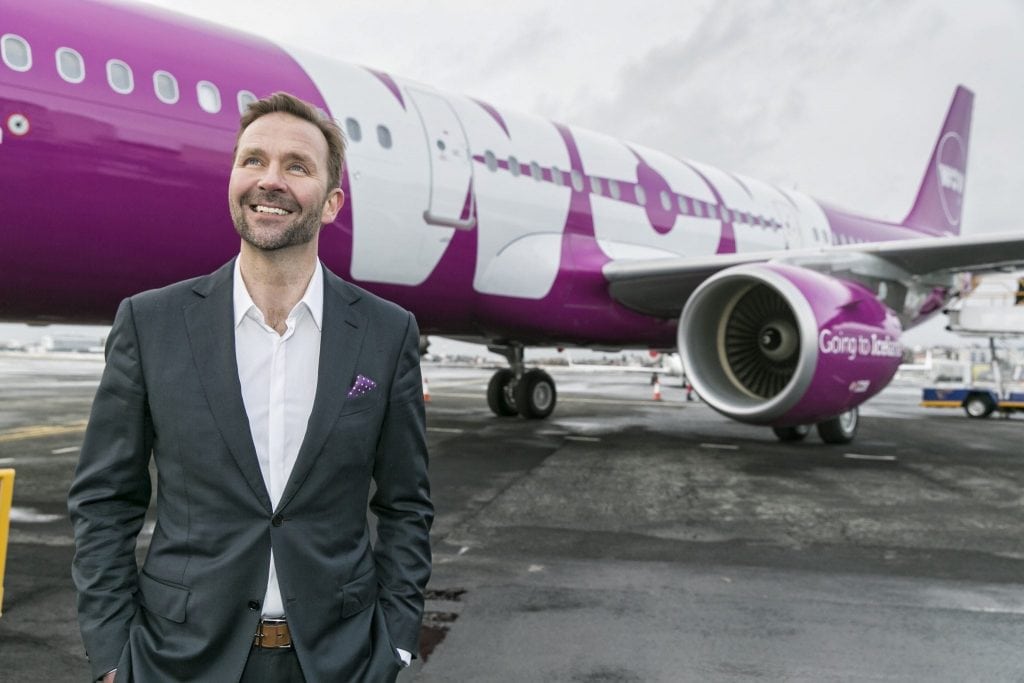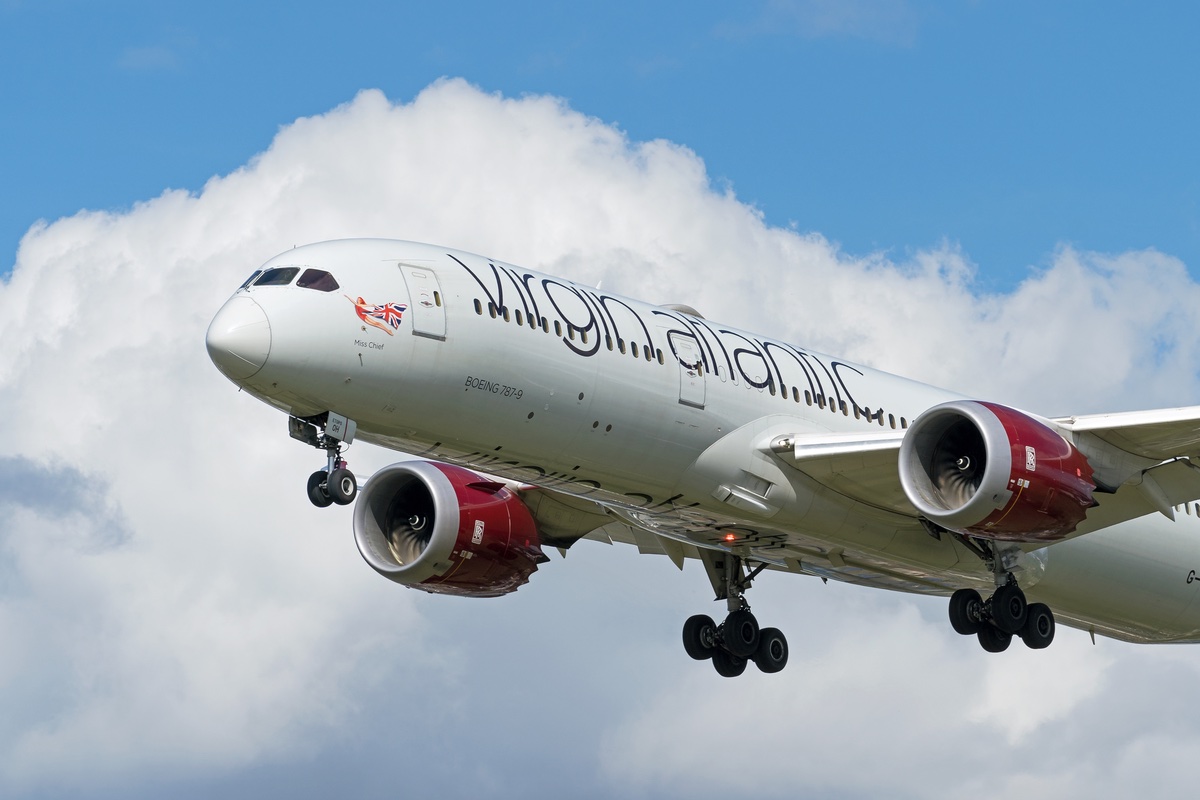Onetime Disruptor Wow Air Is Ready for a Reinvention

Skift Take
When entrepreneur Skúli Mogensen started a new low-cost airline based in Iceland in early 2012, the space was ripe for disruption.
U.S. and European airlines, many newly profitable after a harsh recession, had little interest in thwarting a new entrant with gaudy branding that charged for everything, from larger carry-on bags to sodas. Moreover, Mogensen's airline, called Wow Air, didn't have much low-cost competition across the Atlantic, as Norwegian Air was a smallish European operator then. Perhaps better, Iceland, a newly hot tourist destination, had limited service to the United States, including just one U.S. legacy carrier flight— New York to Reykjavik on Delta Air Lines.
At first, it worked as planned. Wow Air expanded to the United States in 2015, and established players generally left it alone. It skimmed passengers from the bottom of the market, filling aircraft with cost-conscious travelers. Some flew to Iceland for vacation, while others stopped in Reykjavik to save some money on a transatlantic journey. It wasn’t the most comfortable of flights — Wow Air has struggled with operational reliability and customer complaints — but it was cheap.
It's a different market now. In the past year, U.S. and European carriers, which didn’t take the short-haul, low-cost threat seriously in the 1990s and early 2000s, have begun competing vigorously against transatlantic discounters. Mostly, legacy carriers fear Norwegian, as it's considerably larger than Wow, which has only about 20 aircraft. But Wow has been caught in the fray, with big airlines dropping prices in its transatlantic markets.
Wow Air's point-to-point franchise — flying passengers from the United States and Europe to Iceland for vacation — is also under stress. Iceland remains a popular tourist destination, but airlines have probably added more capacity than the country can support. Wow Air's chief domestic competitor, Icelandair, has grown massively recently, and U.S. and European airlines have added flights. (Icelandair's CEO resigned last month, taking blame for what has proven to be an unprofitable growth approach.)
For Mogensen, the timing is not opportune. In an unusual move for an airline CEO, he has been funding Wow since the beginning from “my personal left pocket,” as he said at a conference in early September. He's finally raising outside money as he prepares to take the airline public within two years, seeking to sell bonds at as much as 9 percent interest in hopes he can raise between roughly $50 million to $100 million.
“This is can be a smart strategy, but taking on that kind of leverage will leave Wow Air with little room for error,” said Seth Borko, senior analyst for Skift Research.
Mogensen said he understands the risks, but said the money will help fund Wow's expansion into Asia, part of the strategy to limit the airline's exposure to transatlantic competition.
“The terms reflect the market,” he said in an interview in London at the Aviation Festival, an industry conference. “I don't think the Icelandair situation helped us, neither locally nor necessarily across Europe. Nine percent? Yes, I would have loved to pay less but this is for a first offering, a relatively small offering, helping us bridge toward an IPO where we can refinance at better terms.”
Financial Woes
As a private company, Wow Air has given little information about its finances. But in August, data about its profitability leaked, and it was not a rosy picture.
As recently as 2016, the data show, Wow was solidly profitable, with operating profit of $30 million and operating margin of almost 10 precent.
Between July 2017 and June 2018, according to the document, Wow's operating loss was $45 million, with a negative operating margin: -8.2 percent. For the current year, it predicted finances would improve, with a likely operating loss of about $28 million and margin of -4.2 percent. (For Wow, the third and fourth quarters are generally the most profitable.)
Borko said the airline faces both cost and revenue challenges. He noted the company’s unit revenue has been declining since 2015, and at a faster rate than the U.S. air industry. In addition, he said Wow Air’s costs, not including fuel, “have also been slowly inching higher.”
Mogensen admits the new market conditions have been a drain. And while legacy carriers deserve blame for their competitive stance, Mogensen suggested he is more puzzled at Icelandair, which has tried to mimic some of Wow Air’s North American's strategy, hurting yields at both airlines.
According to CAPA Centre for Aviation, an industry analysis firm, the two Icelandic airlines overlap on 10 routes to North America, including to several cities that likely cannot support so much capacity, including Cleveland and Baltimore. In the five years since July 2013, CAPA said, weekly capacity between North America and Iceland increased almost 300 percent.
“For the first many years they did not look at us, or at least they acted as if we didn't exist," Mogensen said. "Then all of a sudden, they completely changed tactics and they added a lot of destinations overlapping with us and I think it became more of an issue of, ‘What is Wow doing’ rather than focusing on their own business.”
Mogensen said he’s less concerned about larger legacy carriers. For nonstop U.S.-Iceland capacity, those airlines remain small players, as most still have a just handful of daily flights into Reykjavik. They have been more irritating competitors with their new, cheap transatlantic fares — many now offer a version of their no-frills basic economy product between the United States and Europe — but as a businessman, Mogensen said he respects the strategy.
Essentially, he said, established airlines are using extremely high business class fares to subsidize cheap seats in economy. The U.S. airlines pioneered the strategy, but European carriers have been adopting it, too.
“If they are doing a great job in the front of bus making half their revenue on 15 percent of the seats, it will allow them to price their economy very aggressively,” he said. “I have been impressed. The U.S. carriers at large have been far more aggressive in applying the low- cost model — segmenting the seat structure, understanding the passenger, adding ancillary revenue, adding technology. I think that's part of the American culture.”
Strategy Pivot
With new competition, Wow Air is changing its network strategy. It will keep flying frugal passengers between Europe and the United States, and it may add a destination in North America. But increasingly, it’ll be looking east for growth, specifically to India.
In December, it will begin flying to Delhi, offering cheap fares (as low as $199 one-way from Los Angeles) to Americans and Europeans willing to connect in Iceland.
As it did four years ago for the U.S.-Europe market, Mogensen said he expects Wow Air can stimulate demand. He said the market is “massive,” noting 20 percent of all foreign students in the United States come from India. And while Iceland is not on the way from Europe to India, he said some Europeans still will transfer in Iceland to save money.
“I think India is going to be a very important countermove by us rather than for us to be stuck in the middle between North America and Europe,” he said.
It’s a potentially profitable approach. Legacy carriers are highly protective of their transatlantic routes, and are willing to discount pricing to protect share. But India, while a gigantic market, is less important to legacy carriers, particularly those in the U.S. American, Delta, or United might be willing to match prices on San Francisco-Reykjavik-London, but they're less likely to bother on San Francisco-Reykjavik-Delhi.
“Three years ago, we had two cities in North America,” Mogensen said. “Could we have five cities in India in three years? Absolutely.”
That may be true, but some analysts wonder if, even with Wow's pivot, there will still be too much capacity flowing through Iceland.
“The combination of the two carriers growing rapidly is clearly too much given the size of the local market and the competitiveness of the transatlantic [sector],” said Mark Drusch, a vice president focusing on aviation for ICF, a global consulting firm. “Some kind of rationalization of growth and capacity has to happen at some point.”
One way that might happen is for Wow and Icelandair to merge.
“It’s an obvious question," Mogensen said. "Clearly we could rationalize the network and leverage the situation a lot better — a no-brainer. Will it ever happen? I am not sure.”
Ancillary Revamp
Mogensen also expects Wow Air can counter increasing competition by being smarter about how it charges for ancillary products.
For now, the airline is relatively simplistic with its ancillary strategy. Like most discounters, it charges for larger carry-ons and checked bags, as well as food and drinks, and has premium seats that cost more. In many cases, it varies prices according to demand, but the strategy is still relatively rudimentary — not much different than what other carriers try.
Wow can do better, Mogensen said, and he’s interested in examples from the mobile gaming industry. Often, he said, consumers who play games are offered a quick deal, perhaps allowing them to buy another life, or extra ammunition. They must decide within seconds whether they want to pay as little 25 cents for an edge in the game.
Mogensen suspects he can adapt that strategy for an airline.
“I can start taking a couple of dollars through smaller micro transactions throughout the travel experience,” he said. “It can be something as stupid as, you're sitting in 32B in the back of the bus on your way to Iceland. We send you a note and say, 'For another $5, you could be sitting in 15A.'"
The first person to respond would get the seat.
“You might start at $15,” he said. “If no one buys at $15, you could see it coming down to the point where you buy it. I am not saying we are doing exactly that example, but my point is the margin on these kind of things is 95 percent plus, which is the beauty of it. It goes straight to the bottom line."
Icelandair said in a recent release it is hopeful ticket prices will rise next year as airlines pass on higher fuel costs to customers. But Mogensen said that's probably unlikely, predicting that if airlines want to survive, they'll have to get smarter with the extras.
"We like to think that the economy seat is becoming a commodity," he said. "It is wishful thinking to think fares are going to go up, just because oil prices are going up. Competition is going to remain very fierce, so airlines have to become smart and redefine how they make money."




